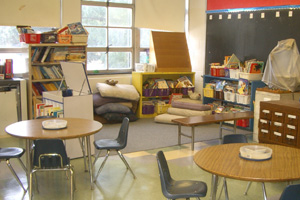| SEND FEEDBACK ABOUT THIS WEBSITE! |
Independence in a First Grade Classroom
Gillian Maimon , Powel Elementary School
Philadelphia, Pennsylvania
Content
What are my students learning?
Teaching Practice
What's my approach?
| Physical Structures | Time Structures |
|---|
Physical Structures |
||||||
The room is set up as a series of familiar, namable spaces. Children make use of key locations like the reading corner, the rug, and the tables in multiple ways. For example, the rug is the place where whole-group instruction happens, and at other times it’s where kids lie on their stomachs and write. The tables are where center work takes place, and at other times they are spots for children to string beads, or mold clay. The simultaneous predictability and flexibility of the room geography facilitates mobility and autonomy. That the map of the room is so familiar makes it possible for some aspects that might automatically be structured in other classrooms to remain unstructured. For example, children do not have permanently assigned seats. While they do have assigned coat hangers and cubbies, the seating is left fluid to match whatever the activity is going on in the room. There are times that I’ll assign groups for the children to work in, but at other times they’re choosing where they sit. I think that this is important responsibility to give kids. In addition, the absence of permanent assigned spots allows us to regard the entire room as community space, rather than a collection of little desk-sized kingdoms. |
||||||
|
||||||


